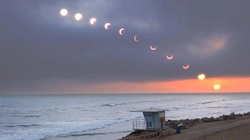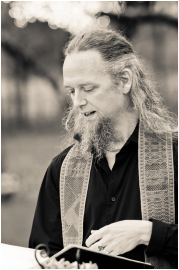
Summer Solstice - solstice from the Latin 'to stand still' (Sol = Sun + Sistire = Stand Still :: think Sthira, for steadiness). And, indeed, for this period of the year, as the sun hits it's highest point on our axis tilt, the days extend longer and longer, until they even seem to 'stand still'. Here, we may not notice it as much, but the more north you go, the more dramatic it is.
I recall being in Copenhagen one July, and after a solid midday of too much fun, we woke up an indeterminate amount of hours later to discover it was light outside, but not very light. Checking our watches and the clock, we determined it was 6 o'clock. Now, we were still worse for the drink, but it took us 30 minutes and an Italian co-hosteler to figure out that it was 6 o'clock in the morning, the next morning, not the same evening. I'm not sure how those folks live like that, the flip side in the winter is having it be dark until 10am, then dark at 3pm. Now, that's straight-up depressing, but the light 'too long' is really disconcerting.
But, I digress. We've got this great solar holiday. It's cyclical, and it speaks to our energetics - personal and cultural. I liken the solar holidays (the major four occurrences; solstices and equinoxes) to the passing of a full cycle of breath for the planet. When the Earth is moving from the Winter Solstice-Alban Arthan (the shortest and darkest day of the year) through the Spring Equinox-Alban Eilir and then into the Summer Solstice-Alban Hefin (the longest and lightest day of the year), this is akin to the inhale.
Starting from full recession and empty, and growing incrementally to complete presence and fullness - the Inhale is known in Sanskrit as Puraka. The Solstice (standing still) acts as the momentary retention; in Sanskrit, this is known as Kumbhaka - retaining the fullness.
After three of these days, the orbit of the sun will begin to diminish in this hemisphere, the days will grow shorter and shorter. This is the beginning of the exhale process, Summer Solstice-Alban Hefin, extending all the way through the Autumnal Equinox-Alban Elfed until the Winter Solstice-Alban Arthan. This Exhale is known in Sanskrit as Rechaka. The energetic is quite different, although the change predicating the shift is incremental and subtle.
Using this metaphor is instructive for me - in order to understand the seasonal shifts and changes, in order to create synergy between myself as living being and cosmos as living entity, and in order to mark time and create celebrations.
One way I love to celebrate the four major solar holidays - equinoxes and solstices - is through doing what we call a 'mini-mala'. A mala is a set of 108 prayer beads for devotional practices. Often, 108 Surya Namaskars are offered as a celebration of a major event or for auspiciousness. So, on the four solar holidays, we do a miniature version of the mala, one-fourth of the total, or simply 27 Surya As.
I like to practice them in three separate rounds of 9 Suryas each, with a long-held contemplative pose held between each of the three sets and followed by a finishing sequence with an inversion. You should spice them up the way you enjoy them best - sometimes I add one push up per Caturanga, other times I may never hop or float, just step... If you are able to commit to 27 Suryas then in each yearly cycle you'll have completed a mala and can keep your own cycle rolling: circle without end is circle without beginning.
Enjoy, we are at the highest energy, greatest potential, most exquisite fullness in these days. Discern, reflect and consider, and then engage in the process of making your life and your experience better, more present and in service to more than your self. This is a Holy Day, so bring devotion to your motion and move like you mean it!!
Give thanks and praise!!





